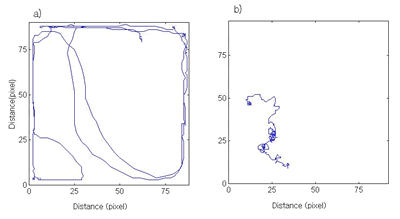
Computational patterning on locomotive behavior of the German cockroach in response to Ca2+ signal-inducing chemicals
T.S. Chon1, K.Y. Park1, S.Y. Choi2, Y.S. Park1, K.T. Kim2 and E.C. Cho3
1Division
of Biological Sciences, Pusan National University, Pusan, Korea
2Division of Biological Sciences, Pohang University of Science
and Technology, Pohang, Korea
3Division of Mathematical Sciences, Kentucky State University,
Frankfort, KY, U.S.A.
Ca2+ signal-inducing chemicals, thapsigargin and ionomycin, and a solvent, dimethyl sulfoxide (DMSO), were administered individually to males of the German cockroach ( Blatella germanica) in topical application. Locomotive tracks were continuously observed through image processing in semi-natural conditions for 4-5 days. After the treatment of the chemicals including DMSO, long-range activity was decreased in scotophase while increased in photophase. Visiting frequencies were generally increased at the drinking place with the treatment of the signal inducing chemicals. Short-range activities at the other microhabitats and diurnal differences appeared in a diverse manner with different chemicals.

Figure 1. Examples of locomotive tracks of the German cockroach, a) untreated, b) treated with ionomycin.
When treated with ionomycin, the locomotive tracks appeared as twisted coils intermittently intervened with the numerous, irregular short-distance turnings resembling a "ball of entangled threads" (Figure 1). This was contrasted with the smooth, linear advancements observed in the untreated individuals. The locomotive tracks were also characterized by the repetition of circular movements for the treatment with thapsigargin, while the treatment with DMSO produced irregular short-distance turnings.
The data for the locomotive tracks were further analyzed by the two-dimensional Fast Fourier Transform (2-D FFT). 2D-FFT effectively brought out periodic data characterizing the patterns of different treatments such as twisted coiling and irregular short-distance turnings in the transformed map. This computational patterning on locomotive tracks could be an alternative to detect changes in response behavior of organisms exposed to various agents of stimuli.
Poster presented at Measuring Behavior 2000, 3rd International Conference on Methods and Techniques in Behavioral Research, 15-18 August 2000, Nijmegen, The Netherlands